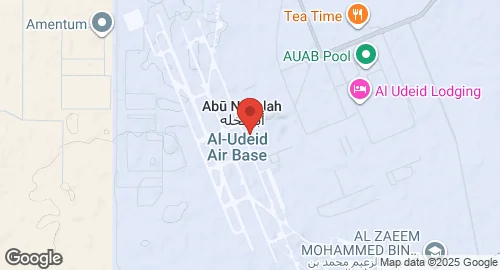Al Udeid Air Base
Summary
| Operating Country | 🇬🇧 United Kingdom • 🇺🇸 United States |
| Location | 🇶🇦 Qatar |
| Status | ◉ Active |
| Usage | Military only |
| Year built | 1996 |
| Operating Organization | US Air Force |
| Units |
|
Description
Al-Udeid Air Base is a military facility located southwest of Doha, Qatar, also known as Abu Nakhlah Airport. Constructed in 1996 at a cost exceeding $1 billion, it has been operational since its establishment. The base is owned by the Qatar Armed Forces and operated by the Qatar Emiri Air Force, United States Air Force (USAF), and the United Kingdom Royal Air Force (RAF), among other foreign forces. It serves as a forward headquarters for U.S. Central Command, headquarters for USAF Central Command, No. 83 Expeditionary Air Group RAF, and the 379th Air Expeditionary Wing of the USAF.
The U.S. first utilized the base in late September 2001 for operations in Afghanistan, with official acknowledgement following in March 2002. In April 2003, the U.S. Combat Air Operations Center for the Middle East relocated to Al-Udeid. The base functions as a logistics, command, and basing hub for U.S. Central Command operations across Iraq, Afghanistan, and Syria. Between 2004 and 2009, the Royal Air Force used the base to support Operation Telic (Iraq War) and Operation Herrick (War in Afghanistan), deploying Tornado GR4 aircraft and Vickers VC10s. During the 2003 invasion of Iraq, the Royal Australian Air Force stationed F/A-18 Hornets, P-3 Orions, and C-130 Hercules aircraft at Al-Udeid, conducting combat and support missions.
Al-Udeid Air Base is the main headquarters for the Qatar Emiri Air Force, housing various squadrons and training units. Since 2014, it has served as the HQ for British involvement in airstrikes against ISIS in Iraq (Operation Shader). The base has two runways: 16L/34R with an asphalt surface, and 16R/34L, both measuring 3,750 meters (12,303 ft). In June 2019, F-22 Raptors were stationed at the base for the first time. An expansion of the base, funded by Qatar at an estimated cost of $1.8 billion, was announced in July 2019. The base was subject to missile strikes on June 23, 2025, in retaliation for U.S. actions targeting Iranian nuclear facilities.
